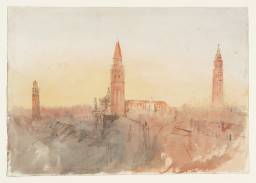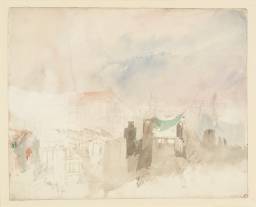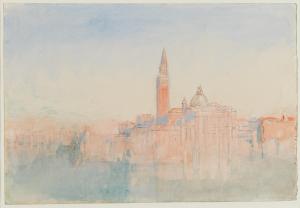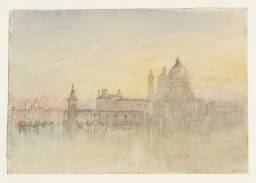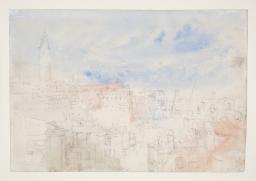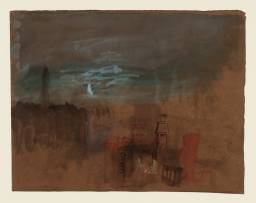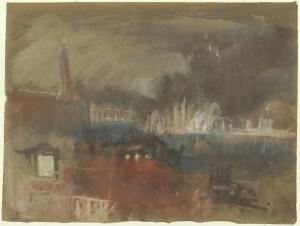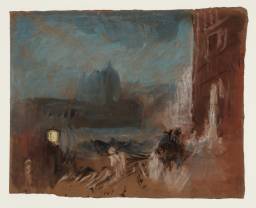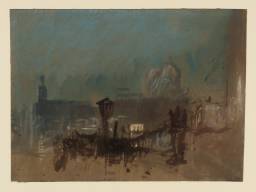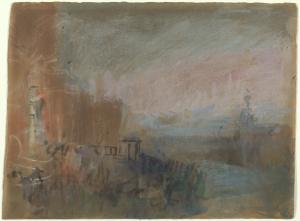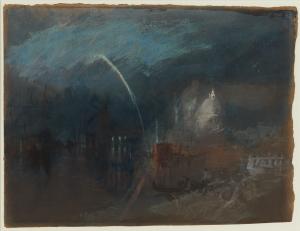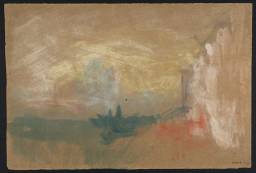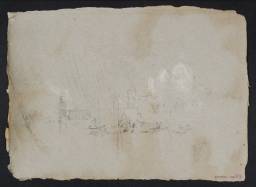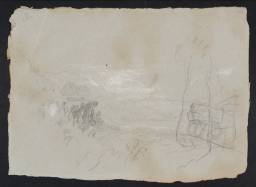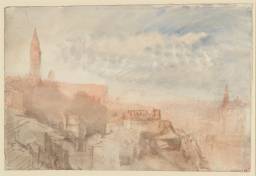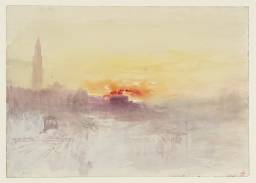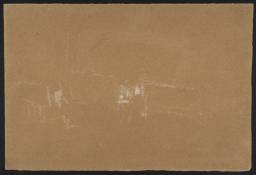Turner Bequest CCCXVI 3, 5, 11, 28, 29, 36, 42, CCCXVII 34, CCCXVIII 5, 10, 11, 13, 19, 29, CCCXIX 1, 6, CCCXLI 183, 183v, CCCLXIV 43, 106
References
This grouping includes watercolour studies showing Venice from inside and around the Hotel Europa, where Turner stayed during his 1840 visit; it is not to be confused with the present Westin Europa & Regina Hotel (the Palazzo Badoer Tiepolo and adjacent buildings on the north side of the entrance to the Grand Canal west of the Rio di San Moisè). The hotel of Turner’s era occupied the Palazzo or Ca’ Giustinian, not far east of the San Moisè canal, with prospects south to the Punta della Dogana and the distinctive porch of the customs house, south-west to the imposing Baroque domes of the church of Santa Maria della Salute, and south-east across the Bacino to the elevation of the entrance front and campanile of San Giorgio Maggiore.
The Europa operated as a hotel from the 1820s until well into the twentieth century;1 Turner’s first stay in Venice in 1819 thus shortly preceded this use, and he stayed at the Leon Bianco, west of the Rialto Bridge on the Grand Canal.2 Nevertheless, two of his four well-known watercolour studies of the city from the 1819 Como and Venice sketchbook show San Giorgio and the Dogana from outside the Palazzo Giustinian (Tate D15254, D15256; Turner Bequest CLXXXI 4, 6). On his next visit, in 1833, he seems to have taken a room there, albeit with his view possibly restricted to the rooftops to the north, as shown in isolated studies of campanili in the Venice sketchbook (Tate D32116; Turner Bequest CCCXIV 100a).3
The same structures are shown from similar angles in a wider (indeed impossibly wide) panorama in one of the 1840 watercolours (D32140; CCCXVI 3), suggesting that he now had a room with views to the north but also ranging to the north-east,4 taking in the campanile of San Marco (St Mark’s), and a further ninety degrees clockwise, south-eastwards to San Giorgio. Although it is generally a moot point as to whether Turner completed or even began his watercolour studies directly from the subject, the airy bedroom scene with St Mark’s and San Giorgio through two of the windows (D32219; CCCXVII 34) is surely a more likely candidate than most. It is one of three, along with D32140 and D32179 (CCCXVI 42) to bear the artist’s proprietorial inscription on the back, identifying the viewpoint as his own room, which no doubt served as a ‘temporary studio’, as Ian Warrell has put it.5 The elevated viewpoint provided opportunities not just for taking in grand vistas under variety of light and weather, but also occasional intimate glimpses of the occupants of nearby buildings.6
Following significant renovations, since 2010 the palace has housed the offices of the Venice Biennale arts organization, as well as various exhibition spaces.7 When the Venetian architect, writer and presenter Francesco da Mosto explored the unrestored building, with ‘most traces of its past ripped out’, for his 2004 television series on Venice, he sought out Turner’s room, noting that ‘we do know he stayed on the top floor’. Cutting directly from a watercolour detail of the campanile through the left-hand window in D32219 to ‘the closest match I can find’ involved filming through a high window in what was by then a narrow bathroom, running north-south at the north-east corner of the main block: ‘Who would have thought that one of the most important places in the history of art would end up a bagno?’. A tall window at its northern end still afforded a view along the Calle del Ridotto, running from the Grand Canal towards the church of San Moisè behind the hotel.8 Today, comparable panoramic views to Turner’s are attainable from the rooftop terrace directly above.9
The rooftop views now associated with the artist’s 1840 stay have sometimes been discussed10 as possibly predating and thus prefiguring the oil painting Juliet and her Nurse, exhibited at the Royal Academy in 1836 (private collection; engraved in 1842 as ‘St Mark’s Place, Venice’: Tate impression T05188).11 It shows a view eastwards to the campanile from high above the Piazza San Marco (St Mark’s Square), with fireworks in the distance; compare in particular D32229 (CCCXVIII 10). As Ian Warrell has noted, while such a supposition had ‘the advantage of these compositional elements’, the dating of colour studies on brown paper to Turner’s 1833 visit (or a spurious one in 1835) has been ‘crucially undermined’ by Cecilia Powell’s technical link with German subjects specific to 1840,12 ‘evidently made on the same sheets’;13 see the overall Introduction to the tour.
See also Tate D34233 (Turner Bequest CCCXLII 41v), a slight chalk drawing of the moon over the Bacino from the vicinity, including in the parallel grouping of views centred on St Mark’s Square owing to its being the verso of one of them. A more substantial statement of the longstanding importance of the hotel and its setting to the artist was the painting he exhibited at the Royal Academy in 1842, titled The Dogano, San Giorgio, Citella, from the Steps of the Europa (Tate N00372),14 which recalls the scene first recorded in his 1819 watercolours.
See ‘Ca’ Giustinian’, La Biennale di Venezia, accessed 11 December 2017, http://www.labiennale.org/en/venues/ca-giustinian .
Noted from commentary and footage in ‘Death’, episode 4 of Franceso da Mosta’s Francesco’s Venice, produced and directed by Sam Hobkinson (BBC, 2004).
See ‘Gallery’ images at ‘Ca’ Giustinian’, La Biennale di Venezia, accessed 11 December 2017, http://www.labiennale.org/en/venues/ca-giustinian .
How to cite
Matthew Imms, ‘Venice: In and around the Hotel Europa 1840’, subset, September 2018, in David Blayney Brown (ed.), J.M.W. Turner: Sketchbooks, Drawings and Watercolours, Tate Research Publication, December 2019, https://www

